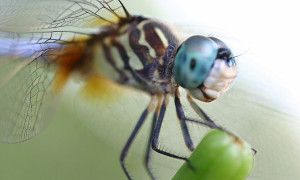 A new machine vision system with applications for surveillance, wildlife monitoring or smart cars is inspired to dragonfly’s eyes and brain. Mechanical Engineering PhD Student Zahra Bagheri at the University of Adelaide in South Australia says that despite having low visual acuity and brains no bigger than a grain of rice, dragonflies are remarkably good at tracking prey.
A new machine vision system with applications for surveillance, wildlife monitoring or smart cars is inspired to dragonfly’s eyes and brain. Mechanical Engineering PhD Student Zahra Bagheri at the University of Adelaide in South Australia says that despite having low visual acuity and brains no bigger than a grain of rice, dragonflies are remarkably good at tracking prey.
“They’re not like mammals which have developed very good brains, and they have very low resolution eyes compared to other animals, but they can catch their prey more than 97 per cent of the time while they’re moving at very high speeds in very cluttered environments,” Bagheri says. “That means they have adopted very efficient methods for target tracking.”
Bagheri is part of a team of engineers and neuroscientists that have used those methods to develop a machine vision algorithm that can be applied in a virtual reality simulation, allowing an artificial intelligence system to ‘pursue’ an object. Her project is a combination of neuroscience, mechanical engineering and computer science, building on years of research in to insect vision already undertaken at the University of Adelaide.
“Detecting and tracking small objects against complex backgrounds is a highly challenging task. Consider a cricket or baseball player trying to take a match-winning catch in the outfield,” Bagheri explains. This is known as selective attention. The dragonfly hunts for other insects, and these might be part of a swarm – they’re all tiny moving objects. Once the dragonfly has selected a target, its neuron activity filters out all other potential prey.
The team has emulated that ability with their algorithm. Rather than trying to perfectly centre the target in its field of view, Bagheri says the system locks on to the background and lets the target move against it. “This reduces distractions from the background and gives time for underlying brain-like motion processing to work. It then makes small movements of its gaze and rotates towards the target to keep the target roughly frontal,” Bagheri says.
This bio-inspired “active vision” system has been tested in virtual reality worlds composed of various natural scenes. The Adelaide team has found that it performs just as robustly as the state-of-the-art engineering target tracking algorithms, while running up to 20 times faster. “We are hoping to test it on a robot – we’re working on that right now. It has diverse applications. It can be used in surveillance, wildlife monitoring, smart cars and even bionic vision.”



